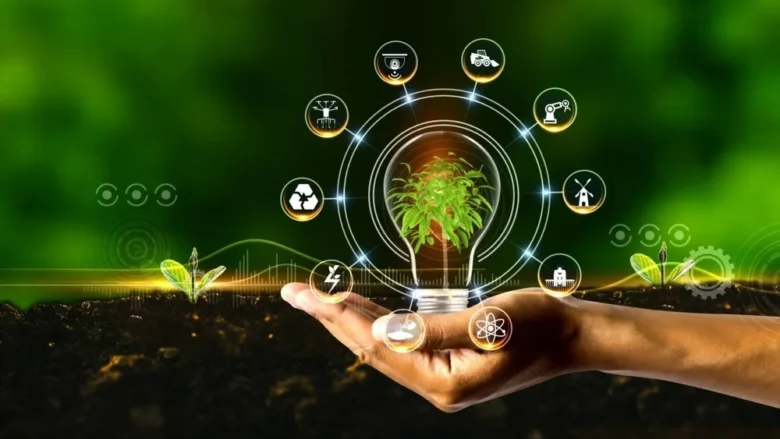Climate disasters are one of the greatest challenges we face today, threatening ecosystems, communities, and economies around the world. But in a world where temperatures are rising, ice caps are melting, and extreme weather is wreaking havoc, green technology is a bright spot. Green technologies include advanced methods to reduce greenhouse gas emissions, increase energy efficiency, and move away from carbon-dependent systems. This article discusses the many ways in which green technology can combat climate change, such as the use of renewable energy and environmentally friendly construction methods. It also discusses the opportunities and challenges the world faces as it moves toward a greener future.
What Role Does Renewable Energy Play?
Renewable energy sources such as hydropower, solar power, and wind power have become a major component of green technology. These technologies do not require fossil fuels to generate energy and can therefore significantly reduce carbon emissions. Solar panels, for example, absorb sunlight and convert it into electricity, making them a reliable and abundant source of energy for homes, businesses, and even remote areas. Wind turbines like this one harness the power of the wind to produce large amounts of clean energy. Large wind farms can power entire cities by grouping these turbines. The movement of water generates electricity, making hydropower particularly useful in areas with abundant rivers. All of these renewable energy systems work together to combat climate change and promote energy independence. They also ensure that future generations will always have access to efficient and clean energy.
Advancements in Sustainable Agriculture:
A large portion of the world’s greenhouse gas emissions comes from agriculture. But thanks to green technology, it is possible to farm in a more environmentally friendly way. Precision agriculture, for example, uses high-tech sensors, data analytics, and GPS mapping to ensure that crops are planted, watered, and fertilized in the best possible way. This process minimizes the waste of resources. Vertical farming is another innovative method that allows plants to grow indoors under controlled conditions. This form of farming is better for the environment than using land and moving food. Recent genetic advances have made crops more resilient to extreme weather conditions, meaning they require less water and chemicals. As more farmers embrace sustainable farming methods, they are reducing pollution and providing themselves with tools to address the challenges caused by climate change.
New Concepts in Green Buildings and Infrastructure:
Buildings and infrastructure have a major impact on the environment. Green technology is helping to advance this field. Modern green buildings strive to reduce their carbon footprint at every stage, from construction to use. Eco-friendly materials, such as insulated walls and low-emission windows, can reduce the need for heating and cooling. Smart building systems with artificial intelligence can make better use of energy by adjusting lighting, temperature, and power consumption in real time. To combat the urban heat island effect and improve air quality, cities and towns around the world are building green infrastructure, such as urban forests and green roofs. With these new ideas, green building technologies can not only reduce pollution but also make living and working environments healthier and more environmentally friendly.
Carbon Capture and Storage Technology:
Green technology not only reduces pollution but also removes carbon dioxide from the air. The most advanced technology in this area is carbon capture and storage (CCS), which captures carbon dioxide emitted by industrial plants and stores it deep in rock formations. This approach would stop carbon gases from being released into the air and would have less impact on climate change. Another rapidly evolving technology is Direct Air Capture (DAC). DAC absorbs carbon dioxide directly from the air and can be used to eliminate previous emissions. It gathers pollutants for the production of new products like concrete or synthetic fuels, thereby fostering a circular carbon economy. Although CCS and DAC technologies are still in their early stages, they are the most promising for achieving net-zero emissions targets.
What Green Technology Means for Economics and Policy:
Renewable technology is not only transforming our response to climate change, but it is also influencing global laws and economies. Governments are using incentives and subsidies to encourage people to buy renewable energy systems, electric vehicles, and other environmentally friendly innovations. International agreements like the Paris Climate Agreement are now focusing on policies that encourage people to reduce their energy consumption and emissions.
On the economic front, green technology is generating jobs in sectors like solar panel manufacturing, wind turbine maintenance, and environmentally friendly agricultural practices. Entrepreneurs are seizing the opportunity to find new ways to solve problems that promote economic growth and address environmental problems. As green technologies gain popularity, the global economy is becoming stronger and more stable. This is true for both businesses and policymakers.
Pros and Cons of Adopting Green Technology:
Despite the promise of green technology, many people struggle to use it. The development of renewable energy systems is hampered by the high initial costs of setting them up, the lack of electric vehicle infrastructure, and limited access to green technologies in developing countries. Misinformation about climate change and opposition from fossil fuel-dependent companies have also created challenges. But these questions also create opportunities for new ideas and collaboration. As technology improves and costs fall, international collaboration through programs like the Green Climate Fund is ensuring that no region is left behind on the path to sustainable development. By addressing these issues, we can make the most of green technologies to combat climate change.
The Future of Green Tech in Combating Climate Change:
Green living is more than just a trend; we need it to address the urgent threat of climate change. The answers to these challenges will change the way we generate energy, grow food, build buildings, and manage emissions. And they will show us how to create a sustainable future. While challenges remain, the rapid pace of innovation and the commitment of individuals, businesses, and governments offer hope. The future of green technology is about more than just helping the planet. It’s about economic growth and a healthier, more resilient world. By investing in green solutions and encouraging global collaboration, we can ensure that future generations can live in a world that can thrive even in difficult times.
FAQs:
1. What is ‘green technology’? How can it help combat climate change?
Innovative solutions that reduce environmental damage, extend product lifespans, and combat climate change are called ‘green technologies.’ They include carbon capture tools, environmentally friendly farming methods, and renewable energy systems.
2. How can using alternative energy sources reduce greenhouse gas emissions?
SExamples of renewable energy sources that can generate electricity without using fossil fuels include solar, wind, and hydropower. Fossil fuels are the main source of greenhouse gases.
3. What role does green technology play in agriculture?
Precision farming, vertical farming, and genetically modified foods are all examples of green technologies used in agriculture. These approaches improve food security while reducing resource use and climate emissions.
4. Does the company have the financial resources to use green technology?
In the long run, you can save money by implementing green technology because your energy and resource consumption decreases. Many governments also offer financial incentives for environmentally friendly projects.
5. What is the most difficult thing about using green technology?
Challenges include high start-up costs, limited infrastructure, and opposition from fossil fuel-dependent companies. However, these challenges are being addressed through better technology and collaboration with other countries.




